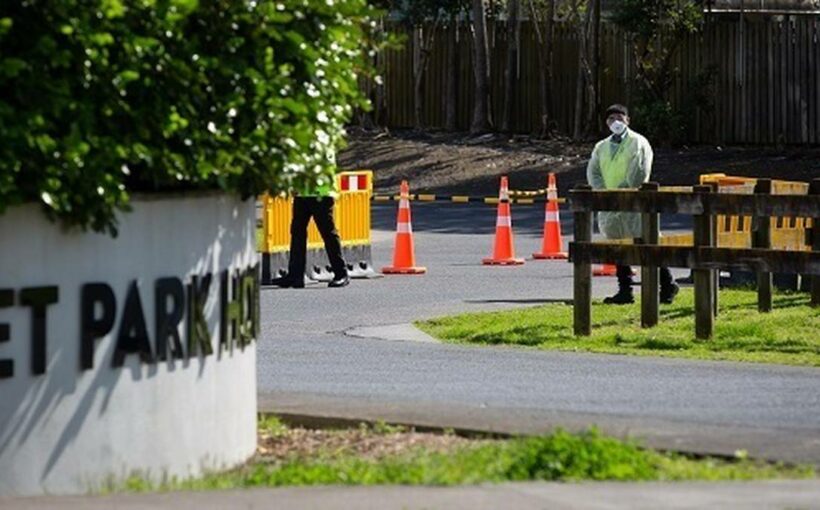There are 49 new Covid-19 cases in the community and MIQ today.
Thirty-nine of the new cases are in the community and 10 are in MIQ. There are four new border cases of Omicron, bringing the total in New Zealand to eight. All the cases have been in MIQ.
Of the 39 new community cases, 25 are in Auckland, 11 are in the Bay of Plenty, two are in Lakes and one is in Taranaki.
Of the 11 new cases in the Bay of Plenty, eight were in Tauranga and three were in the Western Bay of Plenty.
Initial investigations show the Western Bay of Plenty cases and three of the Tauranga cases appear to be linked to existing cases, the ministry said.
The two new infected people in the Lakes district were based in Rotorua.
The Taranaki case was linked to the Eltham cluster.
Forty-nine infected people remain in hospital. There are five infected people in intensive care or high dependency units. Two are in Auckland, two are at Middlemore and one is at North Shore.
Of the patients at Northern region hospitals, 24 (59 per cent) were unvaccinated or not eligible, six (15 per cent) were partially immunised and nine (22 per cent) were fully vaccinated. The vaccination status of the remaining two (5 per cent) was unknown.
Today’s figures do not cover a full 24 hour period due to the change in reporting times to a midnight-to-midnight cycle from 9am-to-9am, the ministry said.
As of today, 3,961,764 first doses (94 per cent of the eligible population) have been given and 3,791,509 second doses (90 per cent).
The number of eligible Māori to get their first vaccine was 495,279 (87 per cent) and 440,400 (77 per cent) had been fully vaccinated.
The number of eligible Pacific Peoples to receive their first dose was 267,999 (93 per cent) and 251,330 (88 per cent) had their second dose.
Eight Omicron cases
Omicron, the latest variant of concern, is believed to be more infectious than the Delta strain of Covid-19 and is sweeping through the United Kingdom and other countries around the world.
Two Omicron cases arrived in New Zealand from Singapore on separate flights – one travelled on a flight to Auckland on December 13 and the second case was on a flight to Christchurch on December 15.
Of the eight Omicron cases, two were in a bubble but the other six cases were unrelated to each other suggesting no cross-contamination or cross-infection either in-flight or within MIQ facilities, the ministry said.
“We are carrying out whole genome sequencing on all new border cases of Covid-19 to rapidly identify any new cases of the Omicron variant,” the Ministry of Health said.
All passengers on flights with Omicron cases were required to complete ten days at a managed isolation facility – rather than spending the last three days at home, the ministry said.
“Our health and MIQ teams around the country have been planning for Omicron cases at the border and will continue to manage all arrivals cautiously.”
Child dies while infected with Covid-19
Ministry of Health officials said in a statement yesterday that a child between the age of zero and 9 had died while infected with Covid.
The tragic death marks the youngest person to die while infected with the virus.
There have now been 49 people who have died since Covid-19 arrived on our shores last year.
Recorded Covid deaths include all cases where a person was classified as having an active case of the virus at the time of death. In some of these cases, the underlying cause of death may have been unrelated to Covid-19.
It is not clear if the child, believed to be a Māori boy from Counties Manukau, had any underlying medical conditions that may have contributed to his death.
Dr Matire Harwood of the Papakura Marae Health Clinic said the child’s death was “tragic and sobering”.
“Although people have been saying Covid is mild, for children with asthma and other respiratory conditions it can be really severe and we know our Māori and Pacific have higher rates of those conditions.”
She said it was critical that we do all we can to prevent children getting the virus.
“The vaccine is the best tool and the sooner we get that into all communities and before school starts the better.
Source: Read Full Article

/cloudfront-ap-southeast-2.images.arcpublishing.com/nzme/5IZIFP3BRI56HL5Y43PDHTTTLI.jpg)
/cloudfront-ap-southeast-2.images.arcpublishing.com/nzme/KOI5FROKYGMCZIKU5IX3RINVR4.jpg)
/cloudfront-ap-southeast-2.images.arcpublishing.com/nzme/YQWQJVBWFR4YZCCXQLTXET4R3U.jpg)